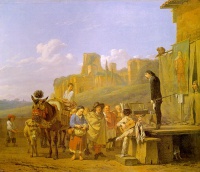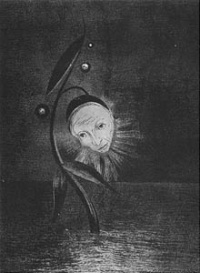Commedia dell'arte
From The Art and Popular Culture Encyclopedia


Illustration: La Fleur du marécage (1885) by Odilon Redon
|
Related e |
|
Featured: |
Commedia dell'arte (Italian: "play of professional artists " also interpreted as "comedy of humors"), also known as Extemporal Comedy, was a popular form of improvisational theater which began in Italy in the 15th century (1400s) and maintained its popularity through to the 18th century (1700s), although it is still performed today. All of their performances were outside with few props, unscripted and were free to watch, funded by donations. In a troupe there were 10 people: 7 men and 3 women. Outside Italy, it was also known as "Italian Comedy".
Subjects of the Commedia dell'arte
Conventional plot lines were written on themes of adultery, jealousy, old age, and love. Many of the basic plot elements can be traced back to the Roman comedies of Plautus and Terence, some of which were themselves translations of lost Greek comedies of the fourth century BC. Performers made use of well-rehearsed jokes and stock physical gags, known as Lazzi and Concetti, as well as on-the-spot improvised and interpolated episodes and routines, called burle (singular burla, Italian for joke), usually involving a practical joke. Since the productions were improvised, dialogue and action could easily be changed to satirize local scandals, current events, or regional tastes, while still using old jokes and punch lines. Characters were identified by costumes, masks, and props, such as a type of baton known as a slapstick. These characters included the forebears of the modern clown, namely Harlequin (English for arlecchino) and Zanni.
The classic, traditional plot is that the innamorati are in love and wish to be married, but one elder (vecchio) or several elders (vecchi) are preventing this from happening, leading the lovers to ask one or more zanni (eccentric servants) for help. Typically the story ends happily, with the marriage of the innamorati and forgiveness for any wrongdoings. There are countless variations on this story, as well as many that diverge wholly from the structure, such as a well-known story about Arlecchino becoming mysteriously pregnant, or the Punch and Judy scenario.
Characters
- Arlecchino - also known as Harlequin. Arlecchino is a clown. Typically acrobatic and mischievous, he is one of the zanni. He is a servant, and recognizable by the colorful diamond-shaped patches that traditionally were part of his costume. The part is sometimes substituted with Truffaldino, his son. His mask has a low forehead with a wart, and he sometimes wore a black stocking wound round the lower face and then up over the head. Arlecchino is often the servant of Pantalone, or sometimes of Il Dottore. He is in love with Colombina, but she only makes fun of him. He can often have a close relationship with the audience, involving them in the action or gesturing to them. The arlecchino character also tries to trick his masters and is always plotting and planning, but his plans never work.
- Brighella - plays either a shopkeeper or servant who is always looking for a way to profit from any given situation, and will cheerfully lie to save himself.
- Il Capitano (The Captain) - swashbuckling and bold, but not necessarily heroic, Il Capitano generally wears the military dress of the day. His attire is generally foppish and overdone. He is usually played as a braggart, a ladies' man, and a cavalier. He is motivated by his desire for sex. Il (or El) Capitano is in many ways similar (though usually younger than) Major Bloodnok of the Goon Show.
- Colombina - is the female counterpart of Arlecchino. She is also a servant and a member of the zanni. She frequently initiates the plot of the play and is usually portrayed as clever, crafty, and untamed. Her costume often had the same colored patches found in Arlecchino's outfit.
- Il Dottore - the doctor, appears to be a learned man, but generally that impression proves to be false. He is elderly, wealthy, and a member of the vecchi. Pedantic and miserly, he is hopelessly unsuccessful with women. In an attempt to impress, he prattles constantly about a topic. Everyone believes that what he is saying is true, but most of the time it is erroneous. This leads the dramatis personae into trouble and confusion.
- The Innamorati are the lovers. The innamorato and innamorata had many different names over time ("Isabella" was a particularly popular name for the woman, as was "Flavio" for the man). They are young, righteous, and hopelessly in love with one another. They wear the most fashionable dress of the day. They never play in mask. Often seen singing, dancing, or reciting poetry, they are frequently portrayed as the children of Dottore and Pantalone. This parentage depends on the circumstances of the plot. They are madly in love, but only manage to surmount the obstacles put in the way of their happiness at the end of the play.
- Pantalone - a member of the vecchi. He is the archetypal "old miser". He is quite wealthy but very greedy. He only cares about money and he will do anything to get it. His costume usually incorporates a long beard and red pants.
- Pedrolino - also known as "Pierrot" or "Pedro", is the loyal servant. He is hardworking, trustworthy, honest and devoted to his master. Charming and likable, he wears a loose white outfit with a neck ruff. When onstage Pedrolino tends to be the butt of physical jokes.
- Pulcinella - sometimes called "Punch," is portrayed as pitiable, helpless, and often physically disfigured. He usually has a hump, a distinct limp, or some other obvious physical deformity. In some portrayals he cannot speak, and expresses himself with squeaks or other strange sounds. His personality can be either foolish or sly and shrewd.
- Sandrone - is represented as a Modenese peasant who is crude, clever, and cunning. He wears a corduroy jacket, short corduroy pants, red and white cross-striped socks, flowers, a vest, farmer's boots, and sports a nightcap with a tassel.
- Scaramuccia - also known as Scaramouche, is a roguish character who wears a black velvet mask, black trousers, a shirt and a hat. He is usually portrayed as a buffoon or boastful coward.
- La Signora is the wife of Pantalone and the mistress of Pedrolino. She is tough, beautiful and calculating. She wears very wide dresses and very heavy makeup. She walks with a flick of the toe and her arms held far out to the sides of her body. She is often played by a man for comedic purposes.
- Tartaglia - short sighted with a terrible stutter, he is one of the stock old characters who appears in many scenarios as one of the lovers. His social status varies; he is sometimes a bailiff, lawyer, notary or chemist. Dramatist Carlo Gozzi turned him into a statesman, and so he remained thereafter. Tartaglia wears a large felt hat, an enormous cloak, oversized boots, a long sword, a giant mustache and a cardboard nose.
- Zanni - an eternally unfortunate servant.
See also

